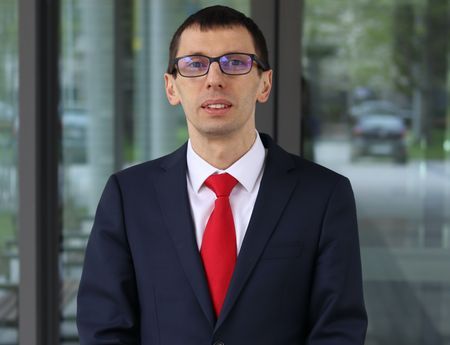
Ready, steady, go! 12 minutes of intense running ahead. The Cooper test will show how our bodies cope with physical effort. In fact, it will indicate how efficient our cells are in producing energy.
We are running really fast, as fast as we can. Our breathing speeds up, the heart beats faster. How far will we be able to run? A few hundred metres more? These questions cross our brains, but the answers are somewhere else – in cells located in different parts of your body: in muscles, heart, lungs, and blood. What’s going on there?
Physical effort generates uncounted changes in our bodies. The system is suddenly thrown off balance, loses equilibrium (homeostasis) and has to quickly adapt to new circumstances. It is when many biochemical processes speed up.
 The goal of this process is to reduce the loss of homeostasis and restore a stable condition, which is largely related to the capabilities of absorbing and using oxygen. Hence, the true result of Cooper test is not so much the distance covered by the runner, but rather the maximum oxygen consumption, our aerobic capacity – the maximum physical effort we are capable of. This factor is referred to as VO2 max (V – volume, O2 – oxygen, max – maximum). In general, it looks quite simple – the more oxygen we can absorb, the more energy we can produce. But why do we need the oxygen?
The goal of this process is to reduce the loss of homeostasis and restore a stable condition, which is largely related to the capabilities of absorbing and using oxygen. Hence, the true result of Cooper test is not so much the distance covered by the runner, but rather the maximum oxygen consumption, our aerobic capacity – the maximum physical effort we are capable of. This factor is referred to as VO2 max (V – volume, O2 – oxygen, max – maximum). In general, it looks quite simple – the more oxygen we can absorb, the more energy we can produce. But why do we need the oxygen?
More glucose, more oxygen
The respiratory system brings oxygen into the body and prepares it for the journey that follows. The oxygen gets into the cells via the vascular system. In the case of an increased effort, the deliveries must be speeded up. The number of breaths increases, the heart is pumping more blood, the blood pressure and oxygen saturation increase.
Moving to a lower level of out internal micro-world, we reach individual cells. A cell contains many enzymes as well as mitochondria, which can be described as power stations supplying the cell “town” with energy. As every power station, they transform one kind of energy into another and need fuel to do this. In this case, the fuel mainly consists of the products of the degradation of glucose and the support provided by oxygen. More fuel and more support means increased production. The final product of the production process – a chain of chemical reactions - is ATP, adenosine triphosphate - our great store of energy.
Cellular respiration involving oxygen is the most efficient one. It results in producing up to 36 ATP molecules from one glucose molecule. Anaerobic respiration (such as the one going on in muscles which haven’t been supplied with the sufficient amount of oxygen) is capable of producing only two ATP molecules from one glucose molecule.
ATP is produced on an ongoing basis to meet the current demand. It supplies energy that fuels many biochemical processes that allow the body to work more efficiently, adapt to changes, and achieve better results during physical effort, such as the Cooper test.
The Magical VO2max
 Coming back to the macro level, let’s take a bit closer look at VO2max. According to the article by Szczepan Wiecha, published on the runners’ website treningbiegacza.pl, the factor “can by compared to horsepower produced by a car engine. When our car has more horsepower, we obviously have better chances of winning. The higher VO2max we can achieve, the greater our capabilities.” It’s been calculated that 15-17 ml/kg/min (milliliters of oxygen per kilogram of body weight per minute) allows minimal effort necessary to perform everyday activities. On the other end of the scale there are athletes who compete in endurance sports: cycling, long-distance running, ski running, cross-country skiing, rowing, etc. Their oxygen efficiency usually ranges from 70 to 90 ml/kg/min. About 50 ml/kg/min is a good result for a man aged 20-30, whereas for a women of the same age group it is about 42 ml/kg/min.
Coming back to the macro level, let’s take a bit closer look at VO2max. According to the article by Szczepan Wiecha, published on the runners’ website treningbiegacza.pl, the factor “can by compared to horsepower produced by a car engine. When our car has more horsepower, we obviously have better chances of winning. The higher VO2max we can achieve, the greater our capabilities.” It’s been calculated that 15-17 ml/kg/min (milliliters of oxygen per kilogram of body weight per minute) allows minimal effort necessary to perform everyday activities. On the other end of the scale there are athletes who compete in endurance sports: cycling, long-distance running, ski running, cross-country skiing, rowing, etc. Their oxygen efficiency usually ranges from 70 to 90 ml/kg/min. About 50 ml/kg/min is a good result for a man aged 20-30, whereas for a women of the same age group it is about 42 ml/kg/min.
It should be stressed that VO2max isn’t the only factor determining our stamina. It can be logically assumed that someone may have huge capacity for absorbing oxygen, but the oxygen may be used ineffectively. It is also possible that a person doesn’t absorb large amounts of oxygen, but his or her metabolism doesn’t involve as many energy-consuming biochemical reactions as it happens in an average body – the oxygen is mainly used to “fuel” the ongoing physical effort.
Different factors related to the features of particular people or environmental conditions can also impact our physical capabilities. This can be, for instance, the amount of haemoglobin in red blood cells. Cheating athletes try to artificially increase its level, whereas anti-doping organisations and sports federations undertake various efforts to combat these attempts, with varying levels of success.
Despite these reservations, the Cooper test is an effective tool of measuring our physical endurance. It is recommended by universities, coaches and sports organizations, like the Polish Society of Sports Medicine.
An interesting fact: Siberian dogs participating in the Iditarod Trail Sled Dog Race have a VO2max of 240 ml/kg/min.
------------------------
Bottom: Fritz Kahn, "Der Mensch als Industriepalast" (Man as Palace of Industry) Stuttgart, 1926. National Library of Medicine.
Original text at: www.nauka.uj.edu.pl




